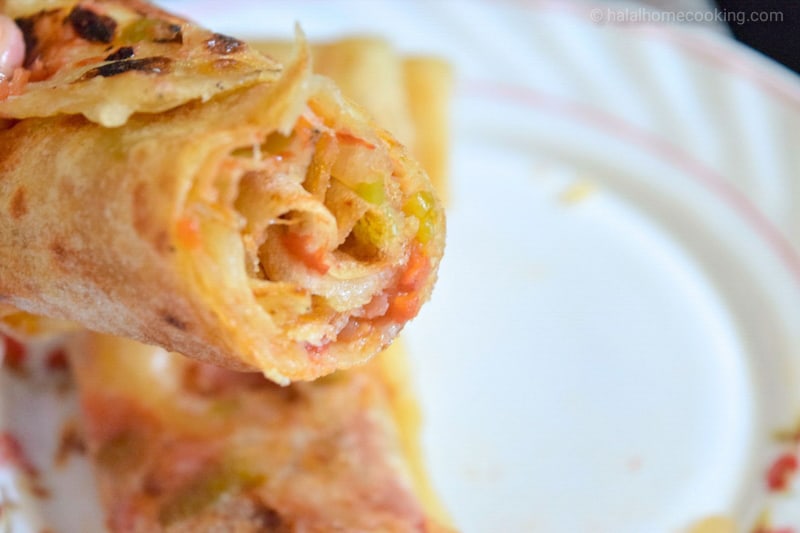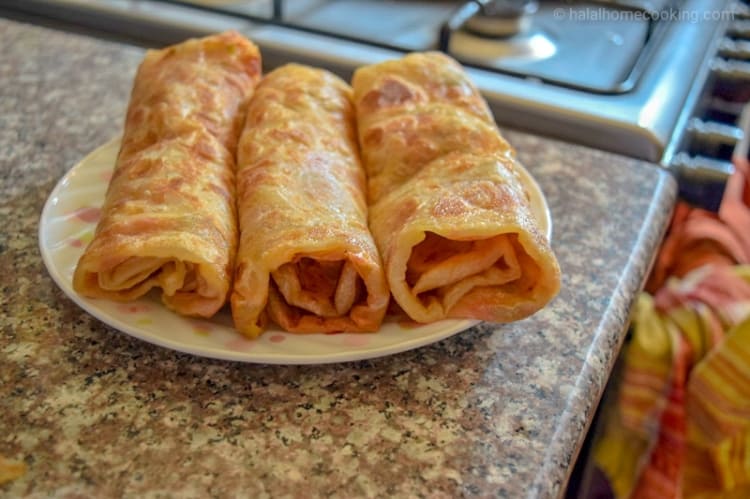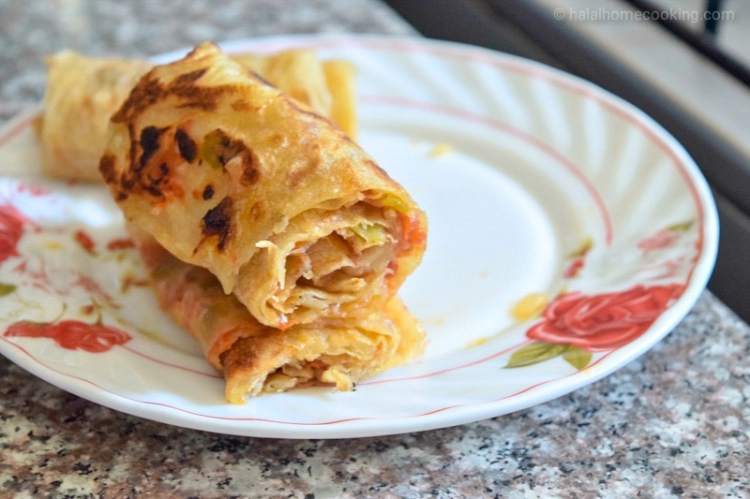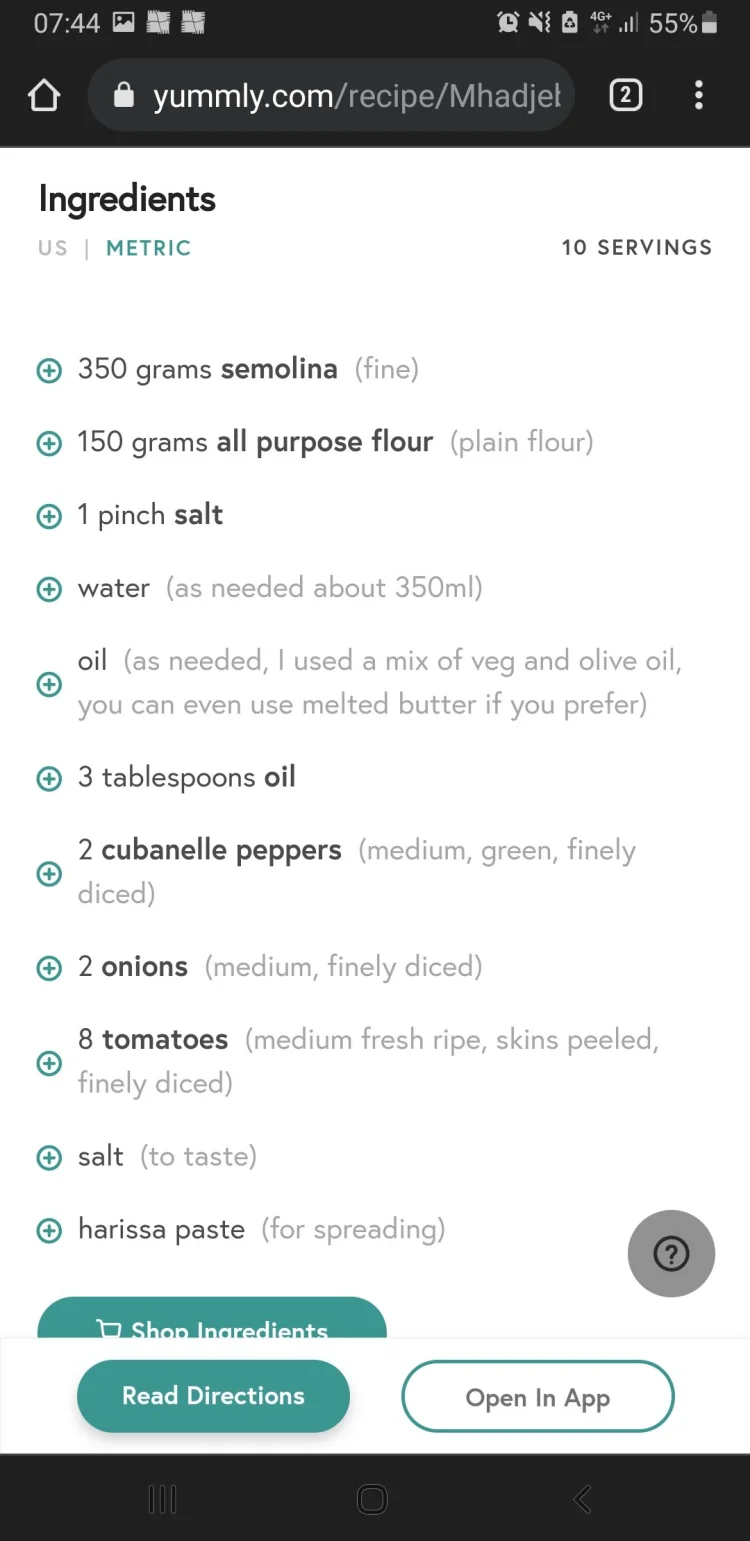Mhadjeb plural Mahdjouba are semolina based crepe-like flatbreads stuffed with chakchouka.
Mhadjeb/Mahdjouba are a popular North African street-food you can recreate at home, anywhere in the world!
You know, even though the plural name for these flatbreads is Mahdjouba, alot of people still call them by their singular form Mhadjeb in every situation therefore, so will I for the rest of this post.
There is already a how-to recipe for Mhadjeb from my days in the UK, where I use a stand mixer for the dough and a food processor for the filling.
Now, here in Algeria I haven’t got a stand mixer and my nutri-bullet blender which was the only appliance really small enough to bring with me, is more suitable for making smoothies or blending sauces than chopping vegetables for the chakchouka filling.
A stand mixer can knead a traditional 100% semolina-based Mhadjeb dough in around 15-20 minutes. It would take at least double that time by hand.
To make it easier and quicker kneading by hand, I use a mixture of flour and semolina. The dough now comes together with only 10 minutes of kneading.
I promise not to ramble on much longer, except to tell you Mhadjeb are worth getting in your kitchen for this summer.
They combine the very best flavours of summer produce wrapped up in rich wafer-thin parcels.
Mhadjeb are a great favourite with kids and adults alike, as they are: chewy and tender yet with slightly crisp exteriors, layered yet flat, savoury and yet kinda sweet AND a little bit spicy – if you add the harissa.
If you are a total novice to Mhadjeb or it’s unstuffed version – Msemmen, it may take you a few attempts to get them right.
Make chakchouka: fry finely diced onions and peppers in oil with salt to taste, until softened. stir in peeled & diced tomatoes, cover and cook over medium heat until the tomatoes have released their juices and then evaporates, remove lid and stir every now and then to check. the chakchouka should be of a chunky jammy consistency, I.e. not very wet. turn off heat and allow to cool to room temperature while you…
Make dough:
in a large mixing bowl mix together thoroughly the semolina, flour and salt, gradually add water until a dough forms then knead for about 10-15 mins by hand (5-7 mins by a dough hook) while gradually adding remaining water little by little until you have a well hydrated, stretchy and supple dough. you may require more of less water than stated in the ingredients list depending on the absorption quality of the flour/semolina you use.
cover dough in a thin layer of oil then divide the dough into 10 equal balls using oiled hands, place on a greased tray and pat with oil and cover with oiled plastic wrap. Allow to rest about 30-40minutes.
Shape and cook mhadjeb:
pre-heat metal tajine/hot plate/crepe maker or large heavy based frying pan (once cooking surface is hot turn heat to low)
Working with one ball of a dough at a time on a greased work surface with oiled hands; first flatten into a circle then gently stretch and pull the dough from the center -outwards working all way around the dough in a clockwise direction until you reach a thin rectangular shape that you can see the worktop through.
Fold the top half of the dough rectangle into the middle then spread on a thin layer of harissa if using, followed by a heaped tbsp of chakchouka. Continue folding up the rectangle; lower half to the middle followed the left and right sides.
Cook Mhadjeb over low heat for a few minutes in total, remember to turn and flip mhadjeb over often for even cooking.
Remove from heat and serve. Best eaten fresh, although re-heating can be achieved preferably on the same cooking surface rather than in an oven/microwave.
If storing wrap well in plastic wrap or put in food bags and store in fridge for a day or two. Can be frozen for upto a month but I’ve personally never tried it.
North African chakchouka stuffed semolina flatbreads
Ingredients
Dough:
- 350 grams fine semolina
- 150 grams all-purpose flour (plain flour)
- Pinch of salt
- Water, as needed about 350ml
For dipping, shaping etc:
- Oil, as needed (I used a mix of veg and olive oil, you can even use melted butter if you prefer)
Filling:
- 3 tablespoons oil
- 2 medium cubanelle peppers (green), finely diced
- 2 medium onions, finely diced
- 8 medium fresh ripe tomatoes, skins peeled, finely diced
- salt, to taste
Optional extras:
- Harissa paste, for spreading
Instructions
- Prepare filling:
- In a large frying pan warm the oil over medium heat, saute peppers and onion with some salt for a few minutes until softened.
- Stir in diced tomatoes, cover pan with a lid, reduce heat slightly and allow to cook – stirring occasionally, until sauce has reduced, it needs to be quite dry.
- Transfer sauce to a large plate or shallow bowl and allow to cool to room temperature then transfer to a smaller bowl if you have a limited workspace.
- Meanwhile…!Prepare dough:
- In a medium size bowl mix together semolina, flour and salt.
- Gradually add the water until it forms a wet sticky dough.
- Continue kneading the dough for 10 minutes until you obtain a soft slightly sticky to the touch dough. I kneaded for the first few minutes inside the bowl and then continued on my worktop. If your dough feels like it’s drying out at any point during kneading (mine didn’t), add a tablespoon at a time of water until you achieve the desired consistency.
- Grease a tray and your hands and have 1/2 cup oil to hand for dipping. Divide dough in to 10 balls – take medium handfuls of dough about 80g each and roll into balls, dip each in oil then place on tray.
- Cover tray with cling flim that you’ve lightly drizzled with oil and allow to rest for 30 mins or until the filling has completely cooled.
Assemble:
- Pre-heat metal tadjine or alternative(see notes) over hight heat then when hot reduce to lowest setting.
- Grease work surface and your hands – repeatedly do this between each mhadjeb.Work with one dough ball at a time, as pictured.
- Using your hands pat to flatten the dough.
- Carefully lift and gently stretch the dough one side at a time into a rectangular shape. Flatten any thick sides with your fingertips.
- Fold the top side of the rectangle into the middle. If using, gently spread a thin layer of harissa paste in the centre of the mhadjeb.
- Followed by a heaping tablespoon of chakchouka filling.
- Fold the side closest to you over the filling until it meets the already folded top side – in the middle.
- Repeat folding the left/right sides into a parcel.
- Drizzle a little oil over the mhadjeb. While lifting and transferring to the metal tadjine, gently pull each side to stretch and make slightly bigger.
Cook:
- Place mhadjeb on pre-heated cooking surface, carefully (it’s hot!) yet quickly, press out the surface to widen the mhadjeb slightly.
- Cook each mhajeb for a minute or two on both sides turning regularly, until lightly golden brown.
- Transfer to a plate and repeat the previous steps with the remaining dough.
Notes
Metal tadjine alternatives: tawa, griddle, crepe pan, large cast iron skillet.
You may run out of chakchouka filling before completing making 10 Mhadjeb. In that case you can make the unstuffed version Msemmen and serve it with your morning tea or coffee.
Enjoy Mhadjeb fresh and warm. They can be allowed to cool, freeze and reheated later however, in this case I definitely feel fresh is best!





